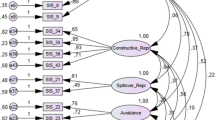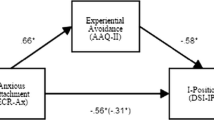Abstract
Social absorption (SA) and social individuation (SI) are two dimensions that may help understand and predict the quality of interpersonal experiences and relationships (Ickes, Hutchison, & Mashek, 2004). A Dutch translation of the SA and SI scales was validated with a circumplex of interpersonal adjective scales, vulnerability factors to depression and attachment style dimensions among a sample of 429 Flemish and Dutch Open University students. Confirmatory factor analysis revealed that SA consisted of two subfactors; SI was shortened for reliability reasons. Subsequent correlational analyses revealed that both SA subfactors correlated positively with warm and assertive interpersonal behaviours, secure attachment style and sociotropy. The shortened SI factor correlated positively with cold and aloof interpersonal behaviours, autonomy and fearful and dismissive attachment. A graphical projection of scales in the interpersonal circumplex further informs the reader about behavioural commonalities between all the variables.(Netherlands Journal of Psychology 65, 40-52.)
Similar content being viewed by others
References
Alden, L. E., & Bieling, P. J. (1996). Interpersonal convergence of personality constructs in dynamic and cognitive models of depression. Journal of Research in Personality, 30, 60-75.
Arbuckle, J. L. (2003). Amos 5.0. Chicago: SmallWaters Corporation.
Aron, A., Aron, E. N., & Smollan, D. (1992). Inclusion of other in the self scale and the structure of interpersonal closeness. Journal of Personality and Social Psychology, 63, 596-612.
Bakan, D. (1966). The duality of human existence. Chicago: Rand-McNally.
Bartholomew, K. (1990). Avoidance of intimacy: An attachment perspective. Journal of Social and Personal Relations, 7, 147-178.
Bartholemew, S. F., & Horowitz, L. M. (1991). Attachment styles among young adults: A test of a four -category model. Journal of Personality and Social Psychology, 61, 226-244.
Beck, A. T. (1983). Cognitive therapy of depression: New perspectives. In P. J. Clayton & J. E. Barnett (Eds.), Treatment of depression: Old controversies and new approaches (pp. 265-290). New York: Raven Press.
Bentsink, A. (2009). Het levensverhaal in interpersoonlijk perspectief: Validatie van de ZKM-typologie [The life story in interpersonal perspective: Validation of the SCM-typology]. Unpublished Master’s thesis, Open University of the Netherlands, Heerlen.
Blatt, S. J. (1974). Levels of object representation in anaclitic and introjective depression. Psychoanalytic Study of the Child, 29, 107-157.
Blatt, S. J. (2004). Experiences of Depression: Theoretical, clinical, and research perspectives. Washington, DC: American Psychological Association
Charania, M., & Ickes, W. (2007). Predicting marital satisfaction: social absorption and individuation versus attachment anxiety and avoidance. Personal Relationships, 14, 187-208.
Castelijn, V. (2007). Verhalen over relaties: een interpersoonlijke benadering van de waarderingstheorie [Relating about relationships: an interpersonal perspective on valuation theory]. Unpublished Master’s thesis, Open University of the Netherlands, Heerlen.
De Schutter, S. (2007). Intersubjectiviteit als sociale absorptie en sociale individuatie: Nederlandstalige validering. [Intersubjectivity as social absorption and social individuation: Dutch language validation]. Unpublished Master’s thesis, Open University of the Netherlands, Heerlen.
Griffin, D. W., & Bartholomew, K. (1994). Models of the self and other: Fundamental dimensions underlying measures of adult attachment. Journal of Personality and Social Psychology, 67, 430-445.
Hazan, C., & Shaver, P. R. (1987). Romantic love conceptualized as an attachment process. Journal of Personality and Social Psychology, 52, 511-524.
Helgeson, V. S. (1994). Relation of agency and communion to well-being. Psychological Bulletin, 116, 412-428.
Horowitz, L. M. (2004). Interpersonal foundations of psychopathology. Washington, DC: American Psychological Association.
Horowitz, L. M., Alden, L. E., Wiggins, J. S., & Pincus, A. L. (2000). Inventory of Interpersonal problems. London: The Psychological Corporation.
Hutchison, J. (1999). Correlates of social absorption and social individuation in the unstructured interactions of opposite-sex strangers. Unpublished Master’s thesis, University of Texas at Arlington, Arlington, Texas.
Hutchison, J., & Ickes W. (1999). Personality Correlates of social absorption and social individuation. Unpublished data, University of Texas at Arlington.
Ickes, W. (2002). The social self in subjective and intersubjective research paradigms. In J.P. Forgas & K.D. Williams (Eds.), The social self: Cognitive, interpersonal and intergroup perspectives (pp 205-218). Philadelphia: Psychology Press.
Ickes, W., Hutchison, J., & Mashek, D. (2004). Closeness as intersubjectivity: social absorption and social individuation. In D. Mashek and A. Aron (Eds.), Handbook of closeness and intimacy (pp. 357-373). Mahwah, NJ: Erlbaum Associates Inc.
Kenny, D. A. (1994). Interpersonal perception: A social relations analysis. New York: Guilford.
Kline, R. B. (1998). Principles and practice of structural equation modelling. New York: The Guilford Press.
Knight, Z. G., & Bradfield, B. C. (2003). The experience of being diagnosed with a psychiatric disorder: Living the label. Indo-Pacific Journal of Phenomenology. Retrieved May 15, 2007, from http://www.ipjp.org/november2003/Knight.pdf
Leary, T. (1957). Interpersonal diagnosis of personality. New York: Ronald Press.
Luyten, P., Soenens, B., Vansteenkiste, M., & Corveleyn, J. (2003). Personal Style Inventory (PSI) Dutch version. Leuven: K.U.L. Centrum voor Psychoanalyse en Psychodynamische Psychologie.
Mashek, D., & Sherman, M. (2004). Desiring less closeness with intimate others. In D. Mashek and A. Aron (Eds.), Handbook of closeness and intimacy (pp.343 -356). Mahwah, NJ: Erlbaum Associates Inc.
McAdams, D. P. (1994). The person: An introduction to personality psychology (2nd ed.). New York: Harcourt Brace.
Morganti, F., Carassa, A, & Riva, G. (Eds.) (2008). Enacting intersubjectivity. A cognitive and social perspective on the study of interactions. Amsterdam: IOS Press.
Mikulincer, M., & Shaver, P. R. (2007). Attachment in Adulthood: Structure, dynamics, and change. New York: The Guilford Press.
Nietzel, M. T., & Harris, M. J. (1990). Relationship of dependency and achievement/autonomy to depression. Clinical Psychological Review, 10, 279-297.
Robins, C. J., Ladd, J., Welkowitz, J., Blaney, P. H., Diaz, R., & Kutcher, G. (1994). The Personal Style Inventory: preliminary validation studies of new measures of sociotropy and autonomy. Journal of Psychopathology and Behavioral Assessment, 16, 277-300.
Van Geel, R. (2000). Agency and communion in self-narratives: A psychometric study of the self-confrontation method. Nijmegen: Nijmegen University Press.
Van Geel, R. (2006). Circumplex Analysis with SPSS (syntax for SPSS). Nijmegen: Open University of the Netherlands.
Van Geel, R., Castelijn, V., Heldens, L., Dercks, C., & Reith, A. (2006). Nederlandstalige (verkorte) versie van Wiggins' Interpersonal Adjective Scale (IAS-48) – proefversie [Dutch (short) version of Wiggins' Interpersonal Adjective Scale (IAS-48) – trial version]. Nijmegen: Open Universiteit Nederland. Unpublished manuscript.
Verboon, P. (1994). A robust approach to nonlinear multivariate analysis. Unpublished Doctoral dissertation, University of Leiden, Leiden
Vanheule, S., Desmet, M., & Rosseel, Y. (2006). The factorial structure of the Dutch translation of the inventory of interpersonal problems: a test of the long and short versions. Psychological Assessment, 18, 112-117.
Van Oudenhoven, J. P., & Hofstra, J. (2004). Hechtingstijlvragenlijst (HSL). Groningen: Rijksuniversiteit Groningen.
Van Oudenhoven, J. P., Hofstra, J., & Bakker, W. (2003). Ontwikkeling en evaluatie van de Hechtingstijlvragenlijst (HSL). Nederlands Tijdschrift voor de Psychologie, 58, 95-102.
Wiggins, J. S. (1979). A psychological taxonomy of trait-descriptive terms: The interpersonal domain. Journal of Personality and Social Psychology, 37, 395-412.
Wiggins, J. S. (1996). An informal history of the interpersonal circumplex tradition. Journal of Personality Assessment, 66, 217-233.
Wiggins, J. S., & Broughton, R. (1991). A geometric taxonomy of personality scales. European Journal of Personality, 5, 343-365.
Zimbardo, P. (1969). The human choice: Individuation, reason, and order versus deindividuation, impulse and chaos. Nebraska Symposium on Motivation, 17, 237-307.
Author information
Authors and Affiliations
Corresponding author
Additional information
School of Psychology, Open University of the NetherlandsCorrespondence to: Rolf van Geel, School of Psychology, Open University of the Netherlands, PO Box 9103, 6500 HD Nijmegen, the Netherlands,
Received 20 May 2008; revision accepted 29 April 2009.
Rights and permissions
About this article
Cite this article
de Schutter, S., van Geel, R., Lodewijkx, H. et al. Social absorption and social individuation: Dutch validation. NEJP 65, 40–52 (2009). https://doi.org/10.1007/BF03080126
Issue Date:
DOI: https://doi.org/10.1007/BF03080126




